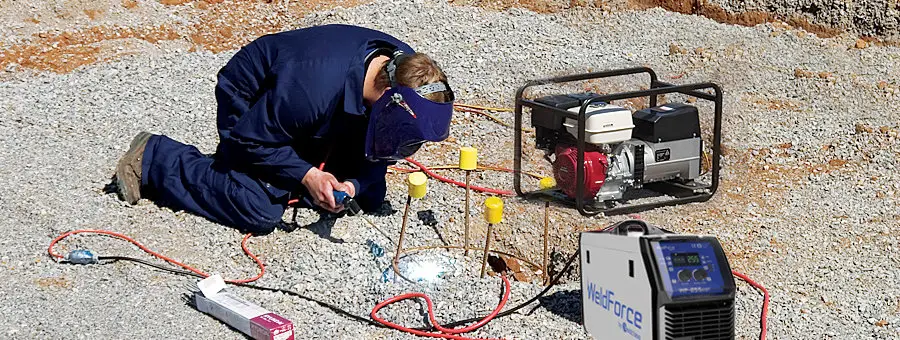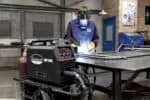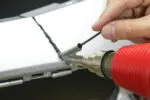Welding can be a very fun and satisfying hobby when you have everything you need to get the desired results.
Sometimes while in the middle of your work, if you have a power cut or something unexpectedly goes wrong with your electrical outputs, it can get quite frustrating not being able to complete your work. In such a situation, it helps to own a generator to plug in your welding machine.
If you are wondering whether your small welder can be operated using a generator, then the answer is YES! A 3000-watt generator can easily support a small welder with an output of 90 to 100 amp to run efficiently.
Almost every type of welder can be used with a generator. We will get more into the details of using a generator to run a welder in this article.
Why use a generator to run a welder?
When you can plug in your welder to a power outlet easily, why do you even need to use a generator to do your welding work, right?
Well, this should not come as a surprise to you that not all welding jobs can be done indoors, or sometimes there may not be any proper electrical outlets for you to be able to plug in the welding machine.
In such cases, using a generator to run your welder is the best way to get the job done. These are portable generators that you can carry with you to your convenient location and simply start your work hassle-free.
The power supply that is created by these generators is enough to fire up all your welding tools at the same time.
Mostly the generators do not need electricity to start, they need fuel, hence, making it even more convenient for you to power up your welding machine.
Which type of generator to use for welding?
We are all quite familiar with the standard generator that we normally use for our homes. Welding machines were being used with these standard generators for a long time.
However, with time as technology advanced, so did the need for a welder-specific generator that serves the purpose of welding machines much better than a normal generator would.
They are called welder generators, which are widely preferred by welders today. It can maintain a consistent electric flow while providing a much higher output compared to a normal generator.
And get this, you can even use it for other appliances that you would use a normal generator for, which is one of their biggest advantages.
You can use all kinds of welders like the MIG, TIG, Stick, Plasma cutter, etc., with the welder generator. So, it is basically a win-win situation from all aspects.
Some welder generators are called workstation generators, which come in several variations like 2 in 1, 3 in 1, and 4 in 1, which are mainly used for industry-level welding work and smaller welding projects too. These types of generators can take a load of a welder, compressor, and battery charger too.
Some of these welder generators even come fully equipped with a welding kit of their own, so you won’t have to plug in a separate welding machine to the generator.
You also get inverter welders and transformer welders, which perform differently from one another when connected to a generator. An inverter welder is capable of running efficiently with any kind of generator due to lesser power usage and smaller transformer requirement.
However, it is important that the welder has an in-built voltage protection system to be able to protect the machine from getting damaged due to voltage fluctuation. The best thing about this type of welder is that you can carry it with you because of its compact size.
Do make it a point to check if the plug is compatible with the generator you have, if not you can always change the plug with one that is compatible.
Whereas, a transformer welder works best with a welder generator. Always make it a point to read the user manual and guide carefully before making any purchase.
How do we weld using a generator?
We have covered all the basics of a welder and a generator, so now it is time for you to learn how to correctly use a generator for welding.
1.) Start by checking the generators’ fuel tank, so that you know there’s sufficient fuel to begin and end your welding work successfully. There should not be a case of the fuel finishing midway, which will directly hamper your flow of work.
2.) You can start your generator once the fuel tank check is done. Your welder must be unplugged before starting the generator.
3.) Once the generator is turned on, you can now connect or plug your welder into it. The outlet should be on the side of the generator, and in case it does not fit or is not compatible, then you can simply make some alterations to the welder plug. After it is plugged in, you can start welding.
(If you have a welder generator then it will perhaps come with its own welding kit. You can then skip this step and move on to the next step.)
4.) The next step should be to have the proper setting in the welding machine’s control settings. This is a necessary step in order to get the right amount of voltage and amps for the welding project in hand. Adjust it according to what will work best to get the desired weld result.
5.) Finally, make sure to turn off all the equipment once the work is done. Doing so will help you save fuel, power, and energy. Plus, protect you from harmful fuel discharge, which can be easily combustible.
For your own safety, please follow the tips and guidelines correctly and be thorough with them.
How do I determine the right size generator for my welder?
This is one of the most commonly asked questions by home welders especially. So, let me help you out by explaining what you need to look for when buying a generator for your welder.
You need to know the maximum and a minimum number of watts your welder will draw to run efficiently to its full capacity. Based on that you can determine the correct generator size.
Normally, a generator’s output is always rendered in watts, so look for the wattage rating on the generator. At least a minimum of 30 amps is required for welding.
The job type and its location will also help you decide on the size of the generator, because for industrial work a large generator will be required, and the same may not be the case if it is for welding at home.
However, if you need to connect more equipment than just the welder to the generator, then the size of the generator will have to increase too.
In such cases, you can go for the workstation generators that can easily take the load of a welder, battery charger, compressor, etc. These generators as previously mentioned come in the combination of 3-in-1 or 4-in 1 to be used for numerous purposes.
Please note that the welding generators will give you a more stable and consistent welding flow because of their stable sine wave, as opposed to a standard generator.
To help you better, you can follow the below-recommended guide that is followed by several welders.
→ For a welding machine with a maximum output of 160 amps, you will need a 7kva generator or greater than that.
→ For a welding machine with a maximum output of 180-200 amps, you will need an 8kva generator or greater than that.
→ For a welding machine with a maximum output of 250 amps, you will need a 13kva generator or greater than that.
Here is a pro tip for you if you are still not 100% sure of what size generator to go for, then the safest bet would be to buy the next bigger size. Because having a small generator may not serve you as well as a bigger one will.
Wrapping up
If you have reached the end of this article, you now understand the importance of having a generator for your welding machine, how to use it correctly, and also the appropriate size that you should purchase. Just remember to always take good care of all your equipment to increase its shelf life.
Whether you decide to keep them indoors or outdoors, make it a point to always store them in a safe and dry place to avoid wear and tear from harmful elements. Happy welding!







